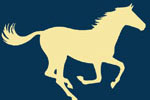Examination & Treatment
What will the examination include?
- Taking a detailed history. This is important as chronic pain may be the result of an injury that occurred and appeared to heal months or even years ago
- Examination and palpation of the horse at rest in the stable. Any areas that are sensitive to light or deep pressure are noted.
- Checking the range of motion of the joints along the spine and limbs
- Trotting up

Manipulating the needles by hand
Where appropriate:
- Assessment of the horse on the lunge and ridden
- Assessment of foot balance
- Checking the fit of the bridle and saddle
Following the examination and treatment, a full report will be sent to your own vet. If any problems that require further investigation or conventional veterinary treatment come to light during the examination, these will be dealt with by your vet.
The Treatment

Electroacupuncture
After this thorough examination, a treatment plan will be devised. This usually includes chiropractic adjustments followed by insertion of needles at acupunture points that are selected especially to treat your horse's individual problems. Between 8 and 21 needles are commonly used; they may be inserted and removed almost immediately or left in for between 10-30 minutes. The needles may be manipulated by hand or attached to a battery-operated electroacupuncture unit to increase the intensity of the stimulation. With certain conditions the needles or the acupuncture points may be warmed by burning a herb called Artemesia vulgaris. This is known as moxibustion.
Treatment may relieve chronic pain for days, weeks, months or even years.
How many treatments will my horse need?

Moxibustion
The number of treatments is variable, depending on the severity of the symptoms and how long the horse has been experiencing problems. A new injury may well resolve with just 1 or 2 treatments. When a horse has been experiencing chronic pain for months or years, between 4-6 sessions may be needed at 1-2 week intervals. However, many of these patients will show an excellent improvement after just 1 or 2 sessions.
Rehabilitation and follow up

Laser acupuncture
When a horse is treated with acupuncture and chiropractic, it is important that it is re-examined prior to each subsequent treatment. This is because its needs will change as recovery begins and previously undetected underlying issues may be identified. Factors which contributed to the problem should be addressed and removed. Following musculoskeletal injuries, advice will be given on an exercise programme and rehabilitation.
How do I manage my horse and how will he feel after treatment?
Most horses feel very relaxed both during and after acupuncture and chriropractic.
They should be left quietly in the stable for about half an hour following treatment and then turned out in the field. Wherever possible they should not do any hard work for 24-48 hours.
After just one session, most owners report a significant improvement in their horse's demeanour. Many comment that the horse has gone back to being a relaxed, friendly animal and they hadn't realised just how grumpy he/she had become.
Summary

The horse is not sedated, just very
relaxed from the treatment
Acupuncture and chiropractic can be used to treat a wide range of conditions. They may be used on their own or to complement conventional veterinary treatment and other therapies including physiotherapy. In many cases, they provide another option when the results of conventional treatment have been disappointing.



